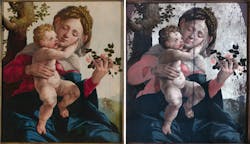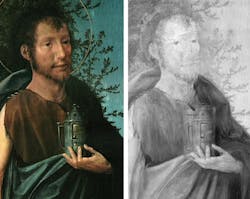Multispectral imaging targets art restoration
The analysis and restoration of paintings requires careful analysis of the structure of the varnish, the pigments used and whether any underlying drawings are present. As well as providing useful information to art restoration experts, such information can also be used to determine whether a painting is original.
To perform this task, multispectral cameras can be used to capture a range of wavelengths, each of which determines a specific feature of the painting. Although a number of companies now offer such multispectral cameras, Art Innovation (Enschede, The Netherlands; www.art-innovation.nl) has specifically targeted this market with its Artist camera.
Like many multispectral cameras, the Artist uses a filter wheel approach to capture images of different bands of the electromagnetic spectrum. Seven glass filters are used in the motorized filter wheel that is placed in front of either a 2 or 5Mpixel monochrome CMOS imager. In this way spectral bands of 300-400nm (UV), 400-500nm (blue), 500-600nm (red), 400-700nm (visible), 700-1100nm (IR) and 1000-1100nm (IR) can be captured by the camera.
"Because many of our customers do not have a technical background," says Benno Aalderink, Applied Research Engineer at Art Innovation, "they do not demand sophisticated image processing software to process the captured images, but favor an easy to operate software package." For this reason, the Artist camera is supplied with software that can be used to display, zoom and compare images. Where more sophisticated processing such as image stitching is required, Art Innovation recommends the PTGui panoramic stitching software for Windows from PTGui (Rotterdam, The Netherlands; www.ptgui.com).
To ensure a reproducible and color-true result, the multispectral camera system is first calibrated by placing a neutral grey card from Fotowand Technic (Sudwale, Germany; www.fotowand.com) in front of the camera.
For art historians and restoration experts, the different wavelengths captured at UV, visible and IR frequencies provide a wealth of information about the paintings themselves. By illuminating these with a UV light source, UV reflectance images can reveal the surface structure of the painting since the UV light will reflect mostly from the top surface of the varnish often used to cover the paint. Alternatively, if the camera is fitted with a UV blocking filter and UV illumination is used, UV fluorescence measurements will show the distribution of pigments over a painting or object. Comparing color and fluorescence images, art historians can then visualize where specific retouching may have occurred (Figure 1. page 13).
At the other end of the electromagnetic spectrum, captured IR images can reveal information about the underlying paint layers or panel conditions of the painting. By using broad spectrum halogen illumination, which have a large IR spectral content, color images and IR images can then be compared (Figure 2).
Illuminating paintings under halogen lighting, the Artist camera can also be operated in a false color IR mode. To accomplish this, red, green, blue and IR images are first captured by the camera. While the blue component is disregarded, the green, red and IR images are then combined to form a composite false-colored IR image. This results in an image with added contrast where any under-drawings can be more easily visualized (Figure 3).
About the Author

Andy Wilson
Founding Editor
Founding editor of Vision Systems Design. Industry authority and author of thousands of technical articles on image processing, machine vision, and computer science.
B.Sc., Warwick University
Tel: 603-891-9115
Fax: 603-891-9297



